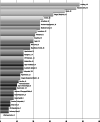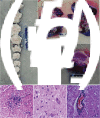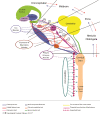Factors associated with fatal outcome of children with enterovirus A71 infection: a case series
- PMID: 29526169
- PMCID: PMC9134374
- DOI: 10.1017/S0950268818000468
Factors associated with fatal outcome of children with enterovirus A71 infection: a case series
Abstract
Enterovirus A-71 (EV-A71) may be fatal, but the natural history, symptoms, and signs are poorly understood. This study aimed to examine the natural history of fatal EV-A71 infection and to identify the symptoms and signs of early warning of deterioration. This was a clinical observational study of fatal cases of EV-A71 infection treated at five Chinese hospitals between 1 January 2010 and 31 December 2012. We recorded and analysed 91 manifestations of EV-A71 infection in order to identify early prognosis indicators. There were 54 fatal cases. Median age was 21.5 months (Q1-Q3: 12-36). The median duration from onset to death was 78.5 h (range, 6 to 432). The multilayer perceptron analysis showed that ataxia respiratory, ultrahyperpyrexia, excessive tachycardia, refractory shock, absent pharyngeal reflex, irregular respiratory rhythm, hyperventilation, deep coma, pulmonary oedema and/or haemorrhage, excessive hypertension, tachycardia, somnolence, CRT extension, fatigue or sleepiness and age were associated with death. Autopsy findings (n = 2) showed neuronal necrosis, softening, perivascular cuffing, colloid and neuronophagia phenomenon in the brainstem. The fatal cases of enterovirus A71 had neurologic involvement, even at the early stage. Direct virus invasion through the neural pathway and subsequent brainstem damage might explain the rapid progression to death.
Keywords: Brainstem damage; Enterovirus A71; Southern China; clinical manifestations; death.
Conflict of interest statement
The authors declare that they have no conflict of interests.
Figures




Similar articles
-
Clinical manifestations of severe enterovirus 71 infection and early assessment in a Southern China population.BMC Infect Dis. 2017 Feb 17;17(1):153. doi: 10.1186/s12879-017-2228-9. BMC Infect Dis. 2017. PMID: 28212620 Free PMC article.
-
Pulmonary and central nervous system pathology in fatal cases of hand foot and mouth disease caused by enterovirus A71 infection.Pathology. 2016 Apr;48(3):267-74. doi: 10.1016/j.pathol.2015.12.450. Epub 2016 Mar 10. Pathology. 2016. PMID: 27020504
-
[Analysis on epidemiological characteristics of enterovirus 71 cases of hand-foot-mouth disease based on the active monitoring in Guangdong Province in 2011-2015].Zhonghua Yu Fang Yi Xue Za Zhi. 2018 Jul 6;52(7):738-742. doi: 10.3760/cma.j.issn.0253-9624.2018.07.011. Zhonghua Yu Fang Yi Xue Za Zhi. 2018. PMID: 29996302 Chinese.
-
Recent advances in enterovirus A71 pathogenesis: a focus on fatal human enterovirus A71 infection.Arch Virol. 2022 Dec;167(12):2483-2501. doi: 10.1007/s00705-022-05606-4. Epub 2022 Sep 29. Arch Virol. 2022. PMID: 36171507 Review.
-
Establishment of Asia-Pacific Network for Enterovirus Surveillance.Vaccine. 2020 Jan 3;38(1):1-9. doi: 10.1016/j.vaccine.2019.09.111. Epub 2019 Oct 31. Vaccine. 2020. PMID: 31679864 Review.
Cited by
-
Contribution of Malaria to Inhospital Mortality in Papua New Guinean Children from a Malaria-Endemic Area: A Prospective Observational Study.Am J Trop Med Hyg. 2019 Apr;100(4):835-841. doi: 10.4269/ajtmh.18-0769. Am J Trop Med Hyg. 2019. PMID: 30793683 Free PMC article.
-
Novel Anti-Enterovirus A71 Compounds Discovered by Repositioning Antivirals from the Open-Source MMV Pandemic Response Box.Pharmaceuticals (Basel). 2024 Jun 14;17(6):785. doi: 10.3390/ph17060785. Pharmaceuticals (Basel). 2024. PMID: 38931452 Free PMC article.
-
Cardiopulmonary failure as a result of brainstem encephalitis caused by enterovirus D68.BMJ Case Rep. 2019 Nov 14;12(11):e231990. doi: 10.1136/bcr-2019-231990. BMJ Case Rep. 2019. PMID: 31732545 Free PMC article.
-
Pathogenesis of enterovirus infection in central nervous system.Biosaf Health. 2023 Jun 14;5(4):233-239. doi: 10.1016/j.bsheal.2023.06.001. eCollection 2023 Aug. Biosaf Health. 2023. PMID: 40078226 Free PMC article. Review.
-
Enterovirus 71 structural viral protein 1 promotes the expression of PMP22 through m6A modification in mouse Schwann cells.Virus Res. 2025 Aug;358:199590. doi: 10.1016/j.virusres.2025.199590. Epub 2025 Jun 4. Virus Res. 2025. PMID: 40480313 Free PMC article.
References
-
- Wang SM, et al. (1999) Clinical spectrum of enterovirus 71 infection in children in southern Taiwan, with an emphasis on neurological complications. Clinical Infectious Diseases: an Official Publication of the Infectious Diseases Society of America 29, 184–190. - PubMed
-
- Lin TY, et al. (2002) The 1998 enterovirus 71 outbreak in Taiwan: pathogenesis and management. Clinical Infectious Diseases: an Official Publication of the Infectious Diseases Society of America 34(suppl. 2), S52–S57. - PubMed
-
- Prager P, et al. (2003) Neurogenic pulmonary edema in enterovirus 71 encephalitis is not uniformly fatal but causes severe morbidity in survivors. Pediatric Critical Care Medicine: a Journal of the Society of Critical Care Medicine and the World Federation of Pediatric Intensive and Critical Care Societies 4, 377–381. - PubMed
-
- Weng KF, et al. (2010) Neural pathogenesis of enterovirus 71 infection. Microbes and Infection/Institut Pasteur 12, 505–510. - PubMed
Publication types
MeSH terms
LinkOut - more resources
Full Text Sources
Other Literature Sources
Research Materials

